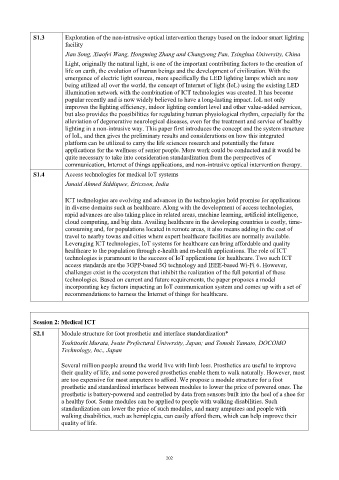Page 222 - ITU KALEIDOSCOPE, ATLANTA 2019
P. 222
S1.3 Exploration of the non-intrusive optical intervention therapy based on the indoor smart lighting
facility
Jian Song, Xiaofei Wang, Hongming Zhang and Changyong Pan, Tsinghua University, China
Light, originally the natural light, is one of the important contributing factors to the creation of
life on earth, the evolution of human beings and the development of civilization. With the
emergence of electric light sources, more specifically the LED lighting lamps which are now
being utilized all over the world, the concept of Internet of light (IoL) using the existing LED
illumination network with the combination of ICT technologies was created. It has become
popular recently and is now widely believed to have a long-lasting impact. IoL not only
improves the lighting efficiency, indoor lighting comfort level and other value-added services,
but also provides the possibilities for regulating human physiological rhythm, especially for the
alleviation of degenerative neurological diseases, even for the treatment and service of healthy
lighting in a non-intrusive way. This paper first introduces the concept and the system structure
of IoL, and then gives the preliminary results and considerations on how this integrated
platform can be utilized to carry the life sciences research and potentially the future
applications for the wellness of senior people. More work could be conducted and it would be
quite necessary to take into consideration standardization from the perspectives of
communication, Internet of things applications, and non-intrusive optical intervention therapy.
S1.4 Access technologies for medical IoT systems
Junaid Ahmed Siddiquee, Ericsson, India
ICT technologies are evolving and advances in the technologies hold promise for applications
in diverse domains such as healthcare. Along with the development of access technologies,
rapid advances are also taking place in related areas, machine learning, artificial intelligence,
cloud computing, and big data. Availing healthcare in the developing countries is costly, time-
consuming and, for populations located in remote areas, it also means adding in the cost of
travel to nearby towns and cities where expert healthcare facilities are normally available.
Leveraging ICT technologies, IoT systems for healthcare can bring affordable and quality
healthcare to the population through e-health and m-health applications. The role of ICT
technologies is paramount to the success of IoT applications for healthcare. Two such ICT
access standards are the 3GPP-based 5G technology and IEEE-based Wi-Fi 6. However,
challenges exist in the ecosystem that inhibit the realization of the full potential of these
technologies. Based on current and future requirements, the paper proposes a model
incorporating key factors impacting an IoT communication system and comes up with a set of
recommendations to harness the Internet of things for healthcare.
Session 2: Medical ICT
S2.1 Module structure for foot prosthetic and interface standardization*
Yoshitoshi Murata, Iwate Prefectural University, Japan; and Tomoki Yamato, DOCOMO
Technology, Inc., Japan
Several million people around the world live with limb loss. Prosthetics are useful to improve
their quality of life, and some powered prosthetics enable them to walk naturally. However, most
are too expensive for most amputees to afford. We propose a module structure for a foot
prosthetic and standardized interfaces between modules to lower the price of powered ones. The
prosthetic is battery-powered and controlled by data from sensors built into the heel of a shoe for
a healthy foot. Some modules can be applied to people with walking disabilities. Such
standardization can lower the price of such modules, and many amputees and people with
walking disabilities, such as hemiplegia, can easily afford them, which can help improve their
quality of life.
– 202 –

